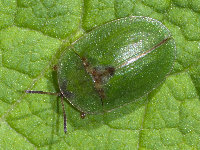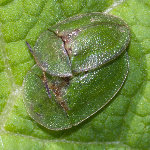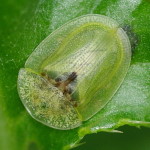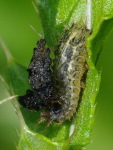Phylum Arthropoda (Arthropods) ➔ Subphylum Hexapoda (Hexapods) ➔ Class Insecta (Insects) ➔ Order Coleoptera (Beetles) ➔ Family Chrysomelidae (Leaf beetles)
Cassida (Cassida) rubiginosa O.F. Müller, 1776
Distel-Schildkäfer Thistle Tortoise Beetle
Further vernacular names:
Green Thistle BeetleClassification:
Cassida rubiginosa belongs to the subfamily Cassidinae, tribe Cassidini.Distribution:
Palearctic (Europe, Asia, North Africa), North America.Habitat:
On moderately fresh to moist meadows, in reed beds and in extensive fields.Description:
Size 6 - 7.5 mm; elytra and pronotum form a wide shield covering the body; pronotum monochrome green; elytra in fully colored animals with red or yellow-brown basal triangle and 4 basal spots and a distinct spot behind the shield; elytra without black spots on the shoulder bulge; lateral margin of the elytra bent and flattened, edge of lateral margin not thickened in the middle; elytra with ± irregular dot stripes, at least in the 3rd and 4th space there are surplus dots; clypeus black; forehead narrow, more than 1/4 longer than broad; legs mostly yellow, at least the 1st third of the femora black; claws toothless at the base.Biology:
The Thistle Tortoise Beetle Cassida rubiginosa is an oligophagous species living on composites (Asteraceae: Carduinae). In Central Europe the beetles are found on thistles (Carduus, Cirsium, Silybum), burdock (Arctium) and knapweed (Centaurea).Cassida rubiginosa forms one generation per year. The adults overwinter and appear in early spring. A female lays about 800 eggs. The eggs are laid in small groups near the tip of a leaf and covered with a reddish-brown secretion. After hatching, the larvae, like the imagines, live and feed on the leaf surface. The greenish or brownish colored larvae carry a shield of faeces and old larval skins, which serves as protection against parasitoids. The pupal period lasts about 8 days. In early summer the new generation of Cassida rubiginosa hatches. The beetles feed on their host plants until autumn and hibernate after maturation feeding.
Natural enemies:
The tachnids Dufouria chalybeata (Meigen, 1824) and Eucelatoria dimmocki (Aldrich, 1932) (Diptera: Tachinidae).Some parasitic wasp species from the families Eulophidae, Chalcididae, Eupelmidae, Mymaridae, Tetracampidae, Trichogrammatidae, Ichneumonidae.
Cerceris albofasciata (Rossi, 1790) (Hymenoptera: Crabronidae: Philanthinae) - Cerceris albofasciata is a predator of tortoise beetles (Cassidinae). The captured beetles are paralyzed and brought into the nest by the females as food for the larvae.
References, further reading, links:
- Rheinheimer, Joachim, & Hassler, Michael: Die Blattkäfer Baden-Württembergs, 2018, 928 pages, Kleinsteuber Books (Karlsruhe), ISBN 978-3-9818110-2-5
- Arved Lompe: Die Käfer Europas - Ein Bestimmungswerk im Internet
- Agelastica alni
- Altica sp.
- Aphthona nonstriata
- Bromius obscurus
- Bruchus rufimanus
- Bruchus sp.
- Cassida nebulosa
- Cassida rubiginosa
- Cassida sp.
- Cassida stigmatica
- Cassida vibex
- Cassida vibex/bergeali
- Cassida viridis
- Chrysolina fastuosa
- Chrysolina haemoptera
- Chrysolina hyperici
- Chrysolina lucidicollis
- Chrysolina oricalcia
- Chrysolina sp.
- Chrysolina sturmi
- Chrysolina varians
- Chrysomela populi
- Chrysomela tremula
- Chrysomela vigintipunctata
- Clytra laeviuscula
- Clytra quadripunctata
- Coptocephala sp.
- Crepidodera aurata
- Crepidodera aurea
- Crepidodera fulvicornis
- Crioceris duodecimpunctata
- Cryptocephalinae sp.
- Cryptocephalus moraei
- Cryptocephalus nitidus
- Cryptocephalus pusillus
- Cryptocephalus sp.
- Donacia bicolora
- Donacia cinerea
- Donacia marginata
- Donacia versicolorea
- Galeruca tanaceti
- Galerucella s.l.
- Gastrophysa viridula
- Gonioctena decemnotata
- Gonioctena quinquepunctata
- Gonioctena quinquepunctata/intermedia
- Gonioctena sp.
- Gonioctena viminalis
- Lema cyanella
- Leptinotarsa decemlineata
- Lilioceris lilii
- Lochmaea caprea
- Neocrepidodera ferruginea
- Neocrepidodera sp.
- Oulema melanopus/duftschmidi
- Oulema obscura
- Pachybrachis sp.
- Phratora sp.
- Phratora vitellinae
- Phyllobrotica quadrimaculata
- Phyllotreta armoraciae
- Phyllotreta nemorum
- Phyllotreta vittula
- Plagiodera versicolora
- Plagiosterna aenea
- Plateumaris sp.
- Podagrica fuscicornis
- Psylliodes sp.
- Pyrrhalta viburni
- Sphaeroderma sp.
- Xanthogaleruca luteola



